SET DESIGNER Part 1
The set designer creates the primary visual environment for the theatre
production. There are five basic goals which reflect the set designer's
balance of aesthetic and practical considerations.
1. The set designer creates a design concept, which extends
the director's production concept into a complete plan for the visual aspects
of the production. The design concept will include the style of the
scenery, the number of scenic locations and how stage action will move
from location to location, and other information gleaned by the designer
from a text analysis. The concept may include a central metaphor
or visual image, like the musical Chess, for which the entire visual
environment was an enormous chess board.
2. Set the style and tone of the production. Today
many theatres do not use the main drape, or curtain which separates the
stage and audience; instead, the audience sees the set when it walks into
the theatre. Therefore, the audience makes assumptions about the
play's style and tone based on the set designer's work, before an actor
walks on stage or a line of the play is delivered. The style might
range from a highly illusionistic setting, in which we might recognize
three walls of a room with complete furnishings, to a more theatrical setting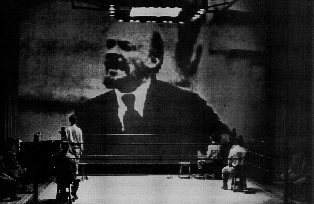 in which we recognize some practical objects which only suggest the full
environment. The tone of the set usually reflects the dramatic genre:
for example, tragedy may use a darker or less varied color pallette and
a few, large objects, whereas comedy may use a brighter and broader color
pallette and many realistic or comically exaggerated details.
in which we recognize some practical objects which only suggest the full
environment. The tone of the set usually reflects the dramatic genre:
for example, tragedy may use a darker or less varied color pallette and
a few, large objects, whereas comedy may use a brighter and broader color
pallette and many realistic or comically exaggerated details.
3. The set gives the first information on time period and location.
A gothic cathedral will tell the audience the play will be set in Medieval
Europe, but a fast food restaurant will probably indicate contemporary
America.
4. Each script presents unique practical problems which
must be solved by a designer; often these practical problems will
help determine the concept and other design decisions for a play.
For example, Miss Saigon requires a helicopter to land on
stage, and Phantom of the Opera requires a chandelier that
swings from high over the audience down to the stage. Once a designer
has found a way to achieve either of these effects, he has begun to establish
a style and determine how the stage must be used in the production.
5. The set designer must coordinate and integrate the scenery
with the other elements of the production: costumes, lights, sounds,
actors, staging needs, and special effects. The effect of all of
these elements should be an integrated whole. The director works
most closely with a director and lighting designer; because the set designer's
the groundplan is necessary to a director when blocking, and the lighting
designer must know all about the scenery she will have to light.
Set Designer's Tools
The set designer has two different sets of tools. One set, the
aesthetic elements of visual composition, is similar to those of other
visual artists. The other tools are the practical objects used to
create stage environments; while almost anything can be put into a stage
setting, in practical terms the same basic structures are used over and
over again.
Visual artists' aesthetic tools:
1. line: the dominant lines of a composition might
be vertical, horizontal, diagonal, curved, or spiral. Line itself may dominate
the composition or only define the edges of masses. The composition below
is dominated by lines that move radially from the center of both the ground
and the background.
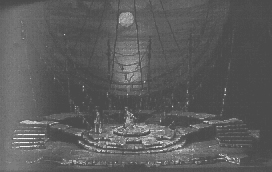
2. mass: the size of the elements on the stage.
On stage, mass relative to the actor's body is important: does the
scenery dominate an actor (a big cathedral, huge stone palace, large
forest) or is it in scale with the actor (an everyday kitchen, a subway
car, a corporate office)?
3. composition: how are the scenic elements arranged
in space (along an x,y, and z axis)? Along any given axis, the composition
might be symmetrical, balanced, or unbalanced.
4. space: positive space is three dimensional space
taken up by scenic objects. Negative space is open space, which may
be taken up by actors and perhaps by movement of actors and other pieces
of scenery. The example below leaves a great deal of negative space, and
dwarfs that actor with its massive size and scale.
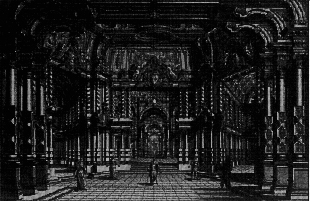
5. texture: can be two dimensional or three
dimensional. Two dimensional texture is variation in color, pattern
and material. Three dimensional texture is a tactile property:
objects could be rough, smooth, silky, bumpy, gritty. Because stage
lights tend to hide an object's texture and because texture is harder to
see across a distance, a scene designer usually exaggerates stage objects'
textures.
6. color: has four properties. Hue
is what we normally think of as color; in paint it is a specific
mix of primary colors red, yellow, and blue; in light it is the wavelengths
absorbed by the object while the rest of the wavlengths are reflected and
caught by the eye. Saturation is how much of the hue, the hue could
be faintly or strongly present. Value is the scale from black (value=0)
to white (value=100); if you think of converting the colors of a
picture into a black and white movie, which is really a grayscale with
black and white at either end of a spectrum, you will arrive at the picture's
values.  Temperature
is a metaphor used for the emotional qualities of a color: reds,
oranges and yellows are warm colors while blues, greens and purples are
cool.
Temperature
is a metaphor used for the emotional qualities of a color: reds,
oranges and yellows are warm colors while blues, greens and purples are
cool.
All of these aesthetic tools will have metaphorical and emotional qualities
for an audience member. Vertical lines might be described as "imposing"
and the color red as "passionate" or "violent". These associations are
culturally relative; in other words they are not innate but learned.
Nevertheless, they can be put to use by a designer who wants his set to
have a specific emotional impact on an audience.
Set designer's practical tools:
While it is usually not a set designer's job to decide how her set
will be constructed or to actually build her set, she needs to know the
common structures used to create stage environments.
Flats: are used to make two dimensional, painted scenery.
Often they are painted in perspective or with other trompe de l'oeil
to give the impression of three dimensional objects. They are usually
constructed of canvas stretched over a wooden frame. Walls, whether
interior or exterior, are often built from flats, which are then painted
and textured to resemble a real building material or interior decoration.
Often flats are used together, by hinging them or lashing them, to represent
three walls of an interior. They are often anchored to the stage
floor with stage braces.
Cutout: is a piece of thin wood or other firm material that is
cut to represent an exterior outline of an object. It may be used
on its own or attached to a flat; for example, a flat representing the
edge of a forest might have a straight edge (the flat) along a tree trunk
and then a cutout representing leaves higher up where the foliage begins.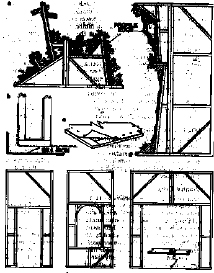
Platforms: are used to add levels to stages, whether a
few steps up into another room of a house, a second story to a building,
or a higher level representing a different location.
Wagons: are platforms that move into place onstage or move around
the stage. The simplest way to make a wagon is to put castors on
a platform. For some shows, tracks and elaborate electrical systems
are installed to run wagons electronically. To raise a wagon or other
set piece vertically, a hydraulic lift is often used.
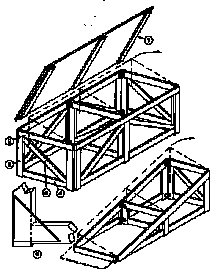
A turntable, or revolve: is a large circular area of a
stage floor that is built to revolve, like an enormous turntable.
Anything from an actor to an entire set can be loaded onto the revolve
and then spun around into place facing the audience. This was the
central scenic device of Les Miserables.
Drops: are large, painted canvases hung from battens. They
could be painted to resemble a city street, a cornfield, or a night sky.
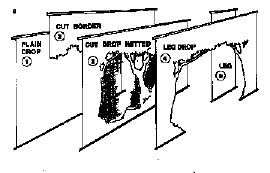
Scrims: are large, loosely woven drops, usually unpainted.
Because of the loose weave of the fabric, the scrim appears opaque when
lit from a front angle but transparent when lit from behind.
Cyclorama: is a large white canvas or plaster structure along
the back of the stage. Lighting designers make most use of a "cyc"
to create the effect of sky or washes of color across the background.
Projections: have been used increasingly through the 20th century
as integral parts of set designs. Projections might be still pictures,
like slides, or moving images shot on video or film. They might be
projected onto a cyc, a flat, or any other object.
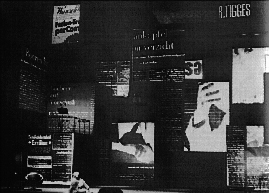
To Set Design
Part 2
BACK TO BLOOD'S COURSE MATERIAL
HOMEPAGE
 in which we recognize some practical objects which only suggest the full
environment. The tone of the set usually reflects the dramatic genre:
for example, tragedy may use a darker or less varied color pallette and
a few, large objects, whereas comedy may use a brighter and broader color
pallette and many realistic or comically exaggerated details.
in which we recognize some practical objects which only suggest the full
environment. The tone of the set usually reflects the dramatic genre:
for example, tragedy may use a darker or less varied color pallette and
a few, large objects, whereas comedy may use a brighter and broader color
pallette and many realistic or comically exaggerated details.


 Temperature
is a metaphor used for the emotional qualities of a color: reds,
oranges and yellows are warm colors while blues, greens and purples are
cool.
Temperature
is a metaphor used for the emotional qualities of a color: reds,
oranges and yellows are warm colors while blues, greens and purples are
cool.



